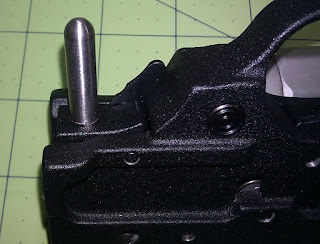 |
| This was supposed to be a 5 shot group! |
I finally made it out to the range to test out the custom Ruger 10/22 I built. I just couldn't wait to see how accurate the rifle was. Unfortunately, I never got to test the accuracy. As soon as I started shooting, I experienced an unusually high rate of failure to fire (FTF) malfunctions. A failure to fire is when a round is loaded into the chamber properly, the hammer drops, but the round doesn't go off. Now it isn't unusual to get a few bad .22 rounds in a batch that won't fire, especially with bulk ammo. But my FTF rate was about 44%, regardless of the brand of ammo! Obviously something else was wrong.
I inspected some of the FTF rounds and noticed that the primer strike looked light. In fact on some of the cases, it looked like the firing pin just barely nicked the outer rim of the case. Since each round was feeding perfectly, and the bolt always closed completely, I thought the firing pin might be the problem.
I used the depth gauge on my digital calipers to measure the firing pin protrusion. It measured 0.018". It should be about 0.035". The bottom of the pin also seemed to be rounded over, almost like it had been dropped or dry fired a lot. Maybe I found the problem? So I ordered a custom firing pin from KIDD Innovative Design. It was specifically designed to address inconsistent ignition.
 |
| Stock Ruger firing pin in front of KIDD firing pin. Notice the KIDD pin is longer. |
The new pin was beautiful. Well as beautiful as a piece of metal can be. The extra quality of the KIDD pin is plainly evident. Installation was very easy, took just a few minutes. With the new pin in, I measured the firing pin protrusion to be 0.036". Much better.
After I reassembled the rifle, I loaded up a few plastic snap caps and pulled the trigger. Rather than the rounded little dimples the original firing pin left, the new pin left a long, deep, well defined dent. As long as it doesn't pierce the case rim, I think we're in business. Only one thing left to do; get out to the range and shoot!
 |
| 3 strikes from the old firing pin and one from the new pin. I'll give you one guess which dent is from the new pin! |
At the range I tested out some CCI Standard Velocity, CCI AR Tactical bulk, and Remington Thunderbolt bulk. Without any regard for accuracy I just squeezed off 10 rounds in rapid succession, swapped mags, and continued until I had fired 100 rounds.
Here are the results.
CCI Standard Velocity: 10 shots, zero FTF
CCI AR Tactical: 30 shots, 2 FTF
Remington Thunderbolt: 60 shots, 3 FTF
Note that all FTFs were with bulk ammo. Each FTF round fired when I loaded it back in the magazine and tried to reshoot it. So, I went from a 44% FTF rate to a 5% FTF rate. Much better and par for the course I suspect with bulk ammo. I am guessing higher quality ammo will function 100%. Problem solved. Now to test for accuracy.
 |
| At the range. |











































